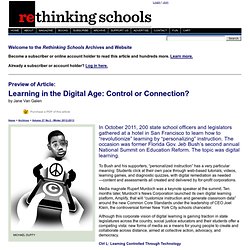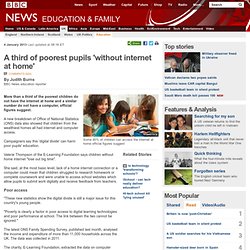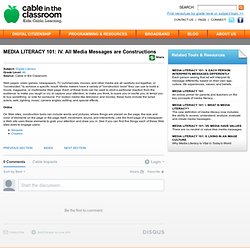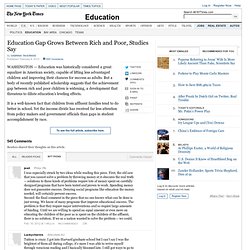

Rebirth of the Teaching Machine through the Seduction of Data Analytics: This Time It's Personal - Philip McRae, Ph.D. It is Personal and Dangerous Now. Rethinking Schools Online. Become a subscriber or online account holder to read this article and hundreds more.

Learn more. Already a subscriber or account holder? Log in here. Learning in the Digital Age: Control or Connection? Antiviral: Here Is What's Bullshit on the Internet This Week. Media Mindfulness.
A third of poorest pupils 'without internet at home' 4 January 2013Last updated at 08:16 ET By Judith Burns BBC News education reporter Some 90% of children can access the internet at home official figures suggest More than a third of the poorest children do not have the internet at home and a similar number do not have a computer, official figures suggest.

A new breakdown of Office of National Statistics (ONS) data also showed that children from the wealthiest homes all had internet and computer access. Campaigners say this 'digital divide' can harm poor pupils' education. The Future of Education. 10 Things Wrong with the Effects Model. MEDIA LITERACY 101: Section IV. Web pages, video games, newspapers, TV commercials, movies, and other media are all carefully put together, or "constructed," to achieve a specific result.

Media makers have a variety of "construction tools" they can use to build a movie, magazine, or multimedia Web page. Each of these tools can be used to elicit a particular reaction from the audience: to make you laugh or cry, to capture your attention, to make you think, to scare you or excite you, to tempt you to buy something, or vote for someone. MEDIA LITERACY 101: Section X.
Gary's Social Media Count. Click for App Store Page Original Counter and Post from 24 Sep 2009! June 2013 ‘Social’ Update (mobile, games & heritage to come) June 2012 ‘Social’ Update August 2011 Update. The Illusion of Choice. It seems like in today’s world there are fewer and fewer people making choices for the greater good. What I mean to say is that everything in our world seems to be able to be consolidated.
The media of course is no exception to this trend with only 6 major companies dictating about 90% of the media we have access to. In less than 30 years the number of companies providing us with our media has dropped from 50 to just 6. The six companies consisting of GE, New-corp, Disney, Viacom, Time Warner, and CBS. If your wondering who owns the major networks its CBS of course, GE owns NBC, News-corp owns fox, and Disney owns ABC. A reason for concern is the gross misrepresentation have so few companies controlling so much causes. The Illusion Of Choice… Profile on TED.com. Is Seeing Believing? Mediacology - Putting the eco into media ecology. Translating Constructivism into Instructional Design: Potential and Limitations. International Perspectives on Youth Media - Home. Digital Youth, Libraries, and New Media Literacy - The Reference Librarian - Volume 52, Issue 4. Hanging Out, Messing Around, and Geeking Out. In The Future, Learning Will Begin At The End.
Critical Pedagogy on the Web: Paulo Freire. Brazilian educator Paulo Freire, perhaps best known for his influential text Pedagogy of the Oppressed , was born on September 19, 1921 in Recife, a port city on Brazil's northeastern coast. Although he was born into a middle class household, his family was severely impacted by the Great Depression, ushering him into the ranks of those who know what it's like to go hungry. Making Access Meaningful: Latino Young People Using Digital Media at Home and at School - Tripp - 2009 - Journal of Computer-Mediated Communication. ‘The computer is not for you to be looking around, it is for schoolwork’: Challenges for digital inclusion as Latino immigrant families negotiate children’s access to the internet. While studies have addressed the role of the internet in the family, the perspectives of Latino immigrant families are largely missing from the research.

This article draws primarily on interview data with first-generation Latino immigrant families living in urban Los Angeles to analyze how parents and their middle school-aged children negotiate access to and use of the internet. Parents in the study were torn between a belief in the educational importance of the internet and a strong sense of anxiety about online risks. Education Gap Grows Between Rich and Poor, Studies Show. It is a well-known fact that children from affluent families tend to do better in school.

Yet the income divide has received far less attention from policy makers and government officials than gaps in student accomplishment by race. Now, in analyses of long-term data published in recent months, researchers are finding that while the achievement gap between white and black students has narrowed significantly over the past few decades, the gap between rich and poor students has grown substantially during the same period. “We have moved from a society in the 1950s and 1960s, in which race was more consequential than family income, to one today in which family income appears more determinative of educational success than race,” said Sean F.
Reardon, a Stanford University sociologist. The changes are tectonic, a result of social and economic processes unfolding over many decades. A Textbook Example of What's Wrong with Education. A former schoolbook editor parses the politics of educational publishing.

Accelerating Change: What is 21st Century Media Literacy? Unless you're 50 years old or older, your attention has turned away from newspapers, magazines, TV and radio and shifted toward internet and electronic delivery of content.

That attention is directed at such diverse areas as using search to find any of the ONE TRILLION sites in Google's index; reading any of the 2.6M articles on Wikipedia; watching some of the 70M+ videos on YouTube; trying to read even a fraction of the 133M blogs; act as one of the 100M users who log on to Facebook daily; or attempt to follow some of the more than 3M tweets sent through Twitter daily.
Adbusters Culturejammer Headquarters. MEDIA STUDIES - The Learning Network Blog. In Online Games, a Path to Young Consumers. Making Curriculum Pop. Professional Development. Professional Development Offerings 2012-2013last updated 11/20/2012 by Project Literacy Among Youth (PLAY) The 2013 catalog of PLAY courses and workshops is available for download (pdf).

You'll find a variety of professional development offerings in the areas of digital media literacy, technology integration, health literacy and connected learning. Admongo.gov. Media Literacy and Awareness.
National Association for Media Literacy Education. Center for Media Literacy. The Media Literacy Clearinghouse #1 Resource For Media Literacy Education.